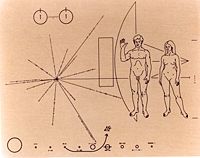
Photo from wikipedia
BACKGROUND Plaque size is a common feature of viral characterization. Small plaque size is used as a marker of attenuation for live-attenuated vaccine development. OBJECTIVE To investigate whether the naturally… Click to show full abstract
BACKGROUND Plaque size is a common feature of viral characterization. Small plaque size is used as a marker of attenuation for live-attenuated vaccine development. OBJECTIVE To investigate whether the naturally occurring plaque size variation reflects virulence of the variants of chikungunya virus (CHIKV). METHODS We selected and purified a variant with small plaque size from the primary isolate. The viral variant was tested for the plaque morphology, in vitro growth kinetics and mouse neurovirulence in comparison with the parental wild type. RESULTS The small plaque size variant showed stable homogenous small plaques after 4 plaque purifications. The small plaque virus grew slower and to the lower titer when compared with wild type virus. After 21 days of infection, mice that received small plaque virus showed 98% survival rate while 74% of mice survived after infected with wild type virus. CONCLUSION The small plaque size variant of CHIKV can be obtained by plaque purification and the virus displays decreased virulence.
Journal Title: Asian Pacific journal of allergy and immunology
Year Published: 2018
Link to full text (if available)
Share on Social Media: Sign Up to like & get
recommendations!